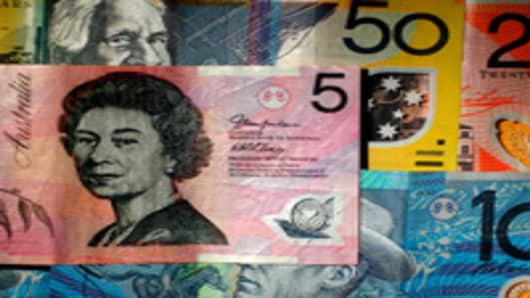Rising prospects of another round of quantitative easing may not be enough to cap the fall in the Australian dollar in the near-term, according to foreign exchange strategists, who see the commodity currency falling to parity against the greenback as early as this week.
The Aussie dollar has fallen out of favor with investors over the last month - declining three percent against the U.S. dollar – due to growing concerns around the slowdown in the country’s largest trading partner, China, coupled with falling commodity prices.
Strategists including Sydney-based Sean Callow, Senior Currency Strategist at Westpac Bank, recommend shorting the currency now, given prospects for further weakness in resource prices as Chinese demand for commodities falls given the slowdown in its economy.
“While it does look increasingly like Mr. Bernanke (U.S. Federal Reserve Chairman Ben Bernanke) will deliver further easing next week, that doesn’t seem to be enough to boost the Aussie in the face of steady flow of negative news from China, weak readings from Chinese industrial sector and a huge price fall in Australia’s number one commodities export – iron ore,” Callow said.
Iron ore – which accounted for 20 percent of the country's total value of exports in 2011 - has suffered a sharp fall in recent weeks on lower demand from mainland steel mills. The benchmark ore with 62 percent iron content has fallen around 25 percent since the start of August to below $90 per metric ton – the lowest level for the commodity since December 2009.
Adding to worries about demand for Australia’s resources was HSBC's China Purchasing Managers Index (PMI), which showed manufacturing activity fell to its its lowest level since March 2009.
Claudio Piron, Head of Emerging Markets Asia Rates Strategy at BofA Merrill Lynch Global Research, adds that the currency’s failure to rally following Fed Chairman Bernanke’s Jackson Hole speech - which left the door open to future central bank action - reflects “negative underlying price action.”
BofA Merrill Lynch forecasts the currency will hit $0.98 within the next two months.
While strategists in Asia-Pacific are recommending shorting the currency, long Australian dollar positions held by speculative investors have been on the rise. But Emma Lawson, Currency strategist at National Bank of Australia, says markets could potentially unwind those positions on concerns over iron prices or policy easing by the Reserve Bank of Australia (RBA).
“There is scope for investors to move out of the Aussie and into other currencies,” Lawson said.
The RBA, which is due to meet on Tuesday, is expected to hold rates at 3.5 percent. However, economists say the risk of a rate cut is building as domestic conditions deteriorate and the slowdown in China worsens.
While Shane Oliver, Chief Investment Strategist at AMP Capital, agrees the Aussie dollar is vulnerable to falling iron ore prices, he says global central banks’ diversification of forex reserves and a recovery in commodity prices will support the currency over the medium-term.



